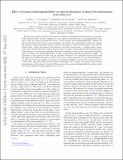Effect of fermion indistinguishability on optical absorption of doped two-dimensional semiconductors
Abstract
We study the optical absorption spectrum of a doped two-dimensional semiconductor in the spin-valley polarized limit. In this configuration, the carriers in the Fermi sea are indistinguishable from one of the two carriers forming the exciton. Most notably, this indistinguishability requires the three-body trion state to have p-wave symmetry. To explore the consequences of this, we evaluate the system's optical properties within a polaron description, which can interpolate from the low-density limit, where the relevant excitations are few-body bound states, to higher-density many-body states. In the parameter regime where the trion is bound, we demonstrate that the spectrum is characterized by an attractive quasiparticle branch, a repulsive branch, and a many-body continuum, and we evaluate the doping dependence of the corresponding energies and spectral weights. In particular, at low doping we find that the oscillator strength of the attractive branch scales with the square of the Fermi energy as a result of the trion's p-wave symmetry. Upon increasing density, we find that the orbital character of the states associated with these branches interchanges. We compare our results with previous investigations of the scenario where the Fermi sea involves carriers distinguishable from those in the exciton, for which the trion ground state is s wave.
Citation
Tiene , A , Levinsen , J , Keeling , J , Parish , M M & Marchetti , F M 2022 , ' Effect of fermion indistinguishability on optical absorption of doped two-dimensional semiconductors ' , Physical Review. B, Condensed matter and materials physics , vol. 105 , no. 12 , 125404 . https://doi.org/10.1103/PhysRevB.105.125404
Publication
Physical Review. B, Condensed matter and materials physics
Status
Peer reviewed
ISSN
1098-0121Type
Journal article
Description
Funding: AT and FMM acknowledge financial support from the Ministerio de Ciencia e Innovación (MICINN), projects No. AEI/10.13039/501100011033 (2DEnLight) and No. MAT2017-83772-R (QLMC-2D). FMM acknowledges financial support from the Proyecto Sinérgico CAM 2020 Y2020/TCS-6545 (NanoQuCo-CM). JL and MMP acknowledge support from the Australian Research Council Centre of Excellence in Future Low-Energy Electronics Technologies (CE170100039). JL and MMP are also supported through the Australian Research Council Future Fellowships FT160100244 and FT200100619, respectively. JK acknowledges financial support from EPSRC program “Hybrid Polaritonics” (EP/M025330/1).Collections
Items in the St Andrews Research Repository are protected by copyright, with all rights reserved, unless otherwise indicated.

